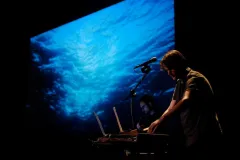Five Questions for Halsey Burgund, Creator of Ocean Voices

Real or imagined, everyone has a story about the ocean. In 2010 sound artist Halsey Burgund teamed up with marine biologist Wallace J. Nichols to record as many of these tales as they could. The result was Ocean Voices.
Originally sponsored by the California Academy of Sciences, Ocean Voices is a website, an interactive audio map, and a mobile app. It is also a musical composition that Burgund wrote, drawing inspiration from the stories he recorded. Burgund has performed Ocean Voices before live audiences at Boston’s Museum of Science and other venues around the country. Performance by performance, recording by recording, Ocean Voices raises awareness about the need to conserve marine life. Take a listen to the stories Burgund has collected in the audio map above. If you want to add your own, head to the Ocean Voices website.
Burgund recently received a Smithsonian Artist Research Fellowship for another project he is working on. We took advantage of his proximity to the Smithsonian's National Museum of Natural History (home of the Ocean Portal), to ask him five questions about Ocean Voices.
What’s the inspiration behind Ocean Voices?
When I was a kid, I spent three weeks every summer with my grandmother on the coast of Maine. I grew up in Connecticut, on Long Island Sound and always felt the pull of the ocean; the mystery of it got embedded in me at a young age. In college, I majored in geophysics with a focus on oceanography. I always like to bring together the different parts of who I am, so when I became a musician and sound artist, I knew I wanted to create a composition inspired by the ocean.
You’ve collected more than 1,200 recordings of people talking about the ocean. What are some of your favorite “voices?”
One of the most amazing ones is of a woman who lives in Tijuana, Mexico. I have no idea who she is or how she found out about the project. It’s this great echoey recording. She talks about what the ocean has meant to her family and says, "its colors are part of my soul. The ocean is silence and at the same time it’s music.” She completely opens up and it’s just this outpouring of emotion that’s not at all preachy.
Another voice I love is of a man who tells a story about growing up in Madrid. Every summer he and his family would visit the ocean. They had a simple game they’d play in the car where they basically competed to be the first one to spot the ocean. To me that story says so much about that moment and his family’s connection to the ocean. That wonderful memory lives on in his mind and I think that visceral connection makes the message of ocean conservation more powerful.
It’s one thing to tell people that carbon dioxide pollution is causing acidification and harming the ocean. But it becomes more real for people if you connect to their personal stories and say these memories may not be possible in the future if CO2 emissions continue to rise.
There’s a push right now to blend science and art. Talk about how you tried to do that with the musical component of this project.
Harkening back to my geophysics days, I used the science of the tides to influence the musical composition. Gravity, the moon, and the Sun cause the tide to rise and fall in predictable patters and times. I looked at the timing of these cycles and translated them into the length that certain instruments play. For example, high tide occurs about every 12.5 hours, so in one section of the piece I had the violin play for 12.5 seconds. I’m trying to mimic the physical process. It's nothing anyone would notice, but to me it was an important philosophical underpinning. I do what I can to tie the music that I write directly to the subject matter, in ways that extend beyond my emotional attachment.
You ask people to share their stories about the ocean, what’s your favorite ocean memory?
It would have to be at my grandmother’s house in Maine. The house was at the end of an island, with a dock, some small boats, and a rocky beach. The water was cold, but I remember wading out and waiting for a lobster boat to go by and then running towards shore once the waves came in. That place gave me the bug of feeling like the ocean is somehow part of me.
What’s next for Ocean Voices?
I hope to hear from a greater variety of people from around the world, especially from those who are not in the ocean “choir.” I’ve collected some 1,200 recordings, but the ocean is huge and everyone on this planet has a relationship to it.

